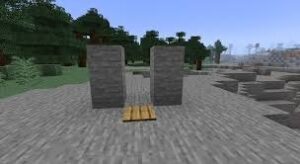How to Make a Redstone Door in Minecraft
Redstone doors are a perfect combination of functionality and creativity in Minecraft. From simple automated entrances to secret hidden bases, these doors add dynamic elements to your builds. In this guide, we’ll show you How to make a redstone door, explore different designs, and share tips for success.
Highlights
- Step-by-step instructions for building redstone doors.
- Learn about different designs, including hidden and large doors.
- Tips for enhancing builds with redstone automation.
What Is a Redstone Door in Minecraft?
A Redstone Door in Minecraft is an automated entrance powered by redstone circuits, allowing players to open and close it without manual interaction. These doors can range from simple setups using pressure plates or levers to advanced designs like hidden piston doors or large 3×3 entrances. Redstone doors add functionality, security, and a creative touch to your builds, making them ideal for secret bases, automated systems, or decorative enhancements. By using redstone components such as sticky pistons, redstone dust, and repeaters, you can create a door that seamlessly integrates into your Minecraft world.
Types of Redstone Doors
– Basic Redstone Door
- Description:
A simple door activated by pressure plates, levers, or buttons. - Key Features:
- Easy to build and suitable for beginners.
- Works with single or double wooden or iron doors.
- Best Use:
Quick and efficient automated access to small bases or rooms.
– Hidden Piston Door (2×2 Design)
- Description:
A concealed entrance that uses sticky pistons to move blocks, revealing or hiding the doorway. - Key Features:
- Blends seamlessly into walls or floors.
- Activated by levers, buttons, or pressure plates.
- Best Use:
Secret bases, hidden rooms, or treasure storage.
– Sliding Door
- Description:
Horizontally moving doors that create a sleek, modern look. - Key Features:
- Uses sticky pistons to push and pull door blocks in a sliding motion.
- Redstone repeaters and dust synchronize the mechanism.
- Best Use:
Modern builds, futuristic themes, or stylish entrances.
– Large Door (3×3 or Bigger)
- Description:
Grand entrances requiring advanced redstone mechanics to move multiple blocks at once. - Key Features:
- Uses an array of sticky pistons, redstone repeaters, and dust for synchronization.
- Often features intricate designs and timing adjustments.
- Best Use:
Castles, fortresses, or elaborate builds with a dramatic entrance.
– Trapdoor-Style Door
- Description:
A hidden door that opens vertically or horizontally using trapdoors or pistons. - Key Features:
- Disguised as part of the floor or ceiling.
- Easy to build and highly functional.
- Best Use:
Secret escape routes or hidden pathways.
Materials Needed to Build a Redstone Door
– Basic Redstone Door (Single or Double)
- Wooden or Iron Doors: 1 or 2, depending on the door type.
- Redstone Dust: To connect the activation mechanism.
- Pressure Plates, Levers, or Buttons: For triggering the door.
- Wooden Pressure Plates for quick entry.
- Iron Buttons or Levers for secure access.
– Hidden Piston Door (2×2 Design)
- Sticky Pistons: 4 (to move the door blocks).
- Building Blocks: 4 (the door’s surface, e.g., stone or planks).
- Redstone Dust: To create the circuit.
- Redstone Torch: To invert signals when needed.
- Lever, Button, or Pressure Plate: For activation.
– Sliding Door
- Sticky Pistons: 4 or more, depending on the door’s size.
- Building Blocks: The sliding door’s material (e.g., glass, wood, or stone).
- Redstone Dust: For connecting pistons.
- Redstone Repeaters: To synchronize the piston movements.
- Activation Mechanism: Button, pressure plate, or lever.
– Large Door (3×3 or Bigger)
- Sticky Pistons: 8 or more (depending on the door’s size).
- Building Blocks: For the door’s surface and surrounding frame.
- Redstone Dust: To link and power the pistons.
- Redstone Repeaters: To time the pistons’ movements.
- Redstone Torch: For signal inversion where necessary.
- Pressure Plates or Buttons: For triggering the mechanism.
– Trapdoor-Style Door
- Trapdoors or Sticky Pistons: 1-4, based on the design.
- Building Blocks: To conceal the trapdoor.
- Redstone Dust: To connect the mechanism.
- Lever or Button: For activation.
Step-by-Step Guides to Build Redstone Doors in Minecraft
– Basic Redstone Door (Single or Double)
- Steps:
- Place the Door(s):
- Place one or two doors in the desired entrance location.
- Add Pressure Plates:
- Place pressure plates on both sides of the door(s) for automatic opening and closing.
- Connect with Redstone Dust:
- Link the pressure plates to the door(s) with redstone dust.
- Test the Door:
- Step on the pressure plates to ensure the door opens and closes automatically.
- Place the Door(s):
– Hidden Piston Door (2×2 Design)
- Steps:
- Build the Wall:
- Construct a wall with a 2×2 space where the door will open.
- Place the Pistons:
- Behind the wall, place 4 sticky pistons (2 on each side) facing the opening.
- Attach Door Blocks:
- Attach the blocks you want to use as the door (e.g., stone or planks) to the pistons.
- Set Up the Redstone Circuit:
- Use redstone dust and torches to connect the pistons to an activation mechanism like a lever, button, or pressure plate.
- Activate and Test:
- Activate the mechanism to open and close the hidden door.
- Build the Wall:
– Sliding Door
- Steps:
- Prepare the Slot:
- Create a horizontal or vertical slot where the door will slide open.
- Place the Pistons:
- Position sticky pistons to push and pull the door blocks into the slot.
- Connect the Circuit:
- Use redstone repeaters and dust to synchronize the pistons.
- Add Activation:
- Connect the circuit to a button or pressure plate for activation.
- Test the Mechanism:
- Press the button or step on the pressure plate to ensure the door slides smoothly.
- Prepare the Slot:
– Large Door (3×3 or Bigger)
- Steps:
- Build the Frame:
- Create a frame with a 3×3 or larger hollow center where the door will fit.
- Place Pistons:
- Arrange sticky pistons to push and pull all the blocks of the door.
- Connect the Redstone Circuit:
- Use redstone dust and repeaters to link the pistons. Adjust timing for synchronization.
- Add Activation Mechanism:
- Use a pressure plate, button, or lever to trigger the redstone circuit.
- Test the Door:
- Ensure all pistons move together to open and close the door seamlessly.
- Build the Frame:
– Trapdoor-Style Door
- Steps:
- Prepare the Surface:
- Build a flat area where the trapdoor will open (e.g., floor or ceiling).
- Install Trapdoors or Pistons:
- Place trapdoors or sticky pistons where the opening mechanism will be.
- Connect the Circuit:
- Use redstone dust to link the trapdoor or pistons to an activation mechanism.
- Test the Mechanism:
- Activate the lever or button to ensure the trapdoor opens and closes correctly.
- Prepare the Surface:
Benefits of Redstone Doors in Minecraft
– Automation: Redstone doors open and close automatically, eliminating the need to manually interact with the door. Ideal for convenience, especially in high-traffic areas like farms, storage rooms, or frequently used pathways.
– Enhanced Security: Iron redstone doors and hidden piston doors add a layer of protection to your base. Prevents unauthorized access in multiplayer servers by using levers, buttons, or coded mechanisms for activation.
– Aesthetic Appeal
- Redstone doors can improve the visual design of your builds:
- Hidden piston doors blend seamlessly into walls or floors for a sleek look.
- Sliding or large doors provide a futuristic or grand aesthetic for modern or castle-themed builds.
– Increased Functionality
- Redstone doors can be integrated into complex systems like:
- Automated farms, allowing mobs or players to enter and exit seamlessly.
- Adventure maps, where doors serve as triggers for puzzles or challenges.
– Creative Freedom: Experimenting with redstone mechanics encourages creativity and problem-solving. Players can customize door designs to fit specific themes, from medieval castles to high-tech labs.
– Learning Opportunity: Building redstone doors introduces players to redstone circuits, pistons, and other advanced mechanics. Serves as a gateway to mastering more complex redstone contraptions like clocks, traps, and automated machines.
Conclusion
Mastering redstone doors in Minecraft opens the door to a world of creativity and automation. Whether you’re creating a simple automatic door or a hidden entrance for a secret base, these mechanisms add both functionality and flair to your builds. With the right materials and a little practice, you can elevate your gameplay and impress your friends with your engineering skills.
Ready to take your Minecraft creations to the next level? Download Minecraft today and start building your own redstone doors! For more expert guides, tips, and creative ideas, follow APKAFE. Transform your Minecraft world with the power of redstone—get started now!
User Reviews








